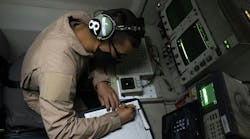By James A. McCorduck and Dr. Kamilo Feher
One way to enable robust operation for various harsh and spectrally efficient channel conditions are enhancements to Standardized Feher Quadrature Phase Shift Keying or FQPSK architectures — particularly wireless channels in frequency selective environments.
FQPSK is a standardized replacement to pulse code modulation/frequency modulation or PCM/FM, which is the modulation technique that has been traditionally used in telemetry systems. FQPSK's significant spectral efficiency over PCM/FM was among the reasons for its selection. This has resulted in the availability of standardized, commercial off-the-shelf (COTS) FQPSK equipment.
In addition to inherent spectral efficiency and operation with non-linearly amplification (NLA) in the transmitter circuits, systems designers can enhance the reception of FQPSK by using innovative receivers including adaptive equalization and smart diversity switching.
These two methods apply different strategies for improving performance in harsh mobile channel environments such as frequency selective fading. Smart diversity systems employ "switching" of receiver paths, which exhibit the best performance, while the adaptive equalizers "improve" the individual path performance. Smart diversity receivers for multi-path frequency selective fading and adaptive equalization, particularly an architecture known as the Feher Equalizer (FE), are of particular interest.
The smart diversity and FE techniques are novel structures, which can provide significant improvement of communication systems performance from more conventional methods.
Background of standardized FQPSK
The amount of spectrum available for allocated aeronautical telemetry spectrum continued to decrease, while demand increased for higher bit rates. This gave the need for proven bandwidth efficient technology a significant priority.
The first steps toward solving these problems were the studies of the performances of various competing technologies in harsh telemetry environments by the Advanced Range Telemetry (ARTM) group at Edwards Air Force Base, Calif. Among those systems evaluated was FQPSK. After thorough and successful flight testing, it was demonstrated that FQPSK "doubled" the bandwidth efficiency of the current legacy systems (Pulse Code Modulation/Frequency Modulation or PCM/FM in this case).
As a result, FQPSK was standardized by the Range Commanders Council (RCC) in the Inter Range Instrumentation Group (or IRIG)-106-01 Standard. Other standardization has followed including recommendation by the Consultative Committee for Space Data Systems (CCSDS) for high bit rate systems, particularly for satellite equipment.
The next step to this process was the commercial development of this technology, which has resulted in the availability and dual use of FQPSK in COTS products.
The CCSDS is an international organization of space agencies cooperating to develop data standards to promote interchange of space-related information. In addition to the adoption of FQPSK by CCSDS, experts have determined that FQPSK waveforms meet the Space Frequency Coordination Group (SFCG) (Spectral) Mask Specifications.
The SFCG is concerned with the effective use and management of those radio frequency bands that are allocated by the radio regulations of the ITU to the Space Research, Space Operations, Earth Exploration Satellite, and Meteorological Satellite services.
These multiyear studies of numerous modulation and transceiver technologies conducted by the U.S. Department of Defense (DOD), NASA, the American Institute of Aeronautics and Astronautics (AIAA). The International CCSDS confirmed that FQPSK COTS products offer the most spectrally efficient robust Bit Error Rate or BER performance of Non-Linearly Amplified (NLA) flight-tested transceivers.
Receiver diversity techniques are generally used for fading channels by providing several different signal paths in the architecture of the receiver. Each path may provide different characteristics for different fading levels. These signal paths can either be "combined" or independently "switched."
The difference between the traditional receiver diversity systems and the novel smart diversity systems lies in the control for the switching of the branch paths. However, the branch with the highest C/N in frequency selective environments may not necessarily have the best performance. The traditional receiver will rely upon the carrier to noise or C/N of the received signal, whereas the smart diversity receiver uses "on-line" monitoring or a pseudo-error detector, which evaluates the BER performance of each of the branches.
The novelty of the smart diversity technique is the selection of the best performing branch in the receiver diversity system. This is performed by implementing a system that monitors the BER of each branch using the pseudo error detector described above thus providing this information to the control signal of the hitless switch.
Adaptive equalization
Another method of performance improvement in receiver systems involves adaptive equalization. The approach here is to improve the performance of the individual signal path rather than switching away to another signal path.
Using pseudo error detection for control circuitry, the adaptive equalizer compensates for a fade notch by placing another notch at a different location within the signal bandwidth.
This structure provides a simple approach for adaptive equalization without significant complexity (i.e. adding a significant amount of taps to the system). This structure is also known as the Feher Equalizer or FE. This novel equalizer can be used on a large class of modulating signals as well
The FE and smart diversity systems provide different approaches, which offer simple solutions for system performance improvement in harsh channel environments for FQPSK and other systems. As a result, these techniques may be applied to other applications requiring significantly improved performance in multi-path fading and other channel conditions.
James A. McCorduck of MatrixSat Inc. is a member of the IEEE and a graduate of the University of California, Davis. He can be reached by phone at 916-338-4482 and by email at [email protected]. Dr. Kamilo Feher, a IEEE Fellow, is a professor at the University of California, Davis and president of FQPSK Consortium — Digcom, Inc. He can be reached by phone at 530-753-0738 and by email at [email protected].


